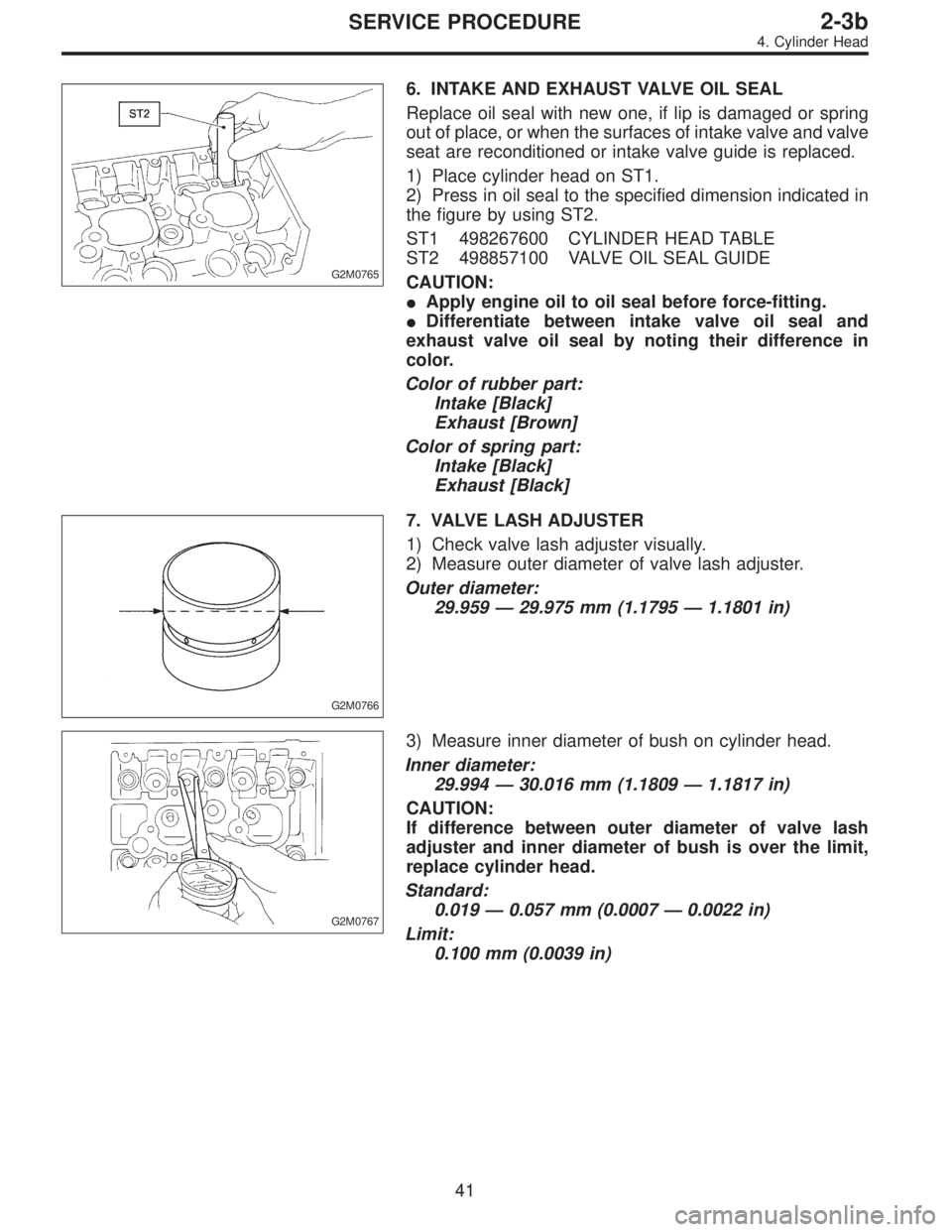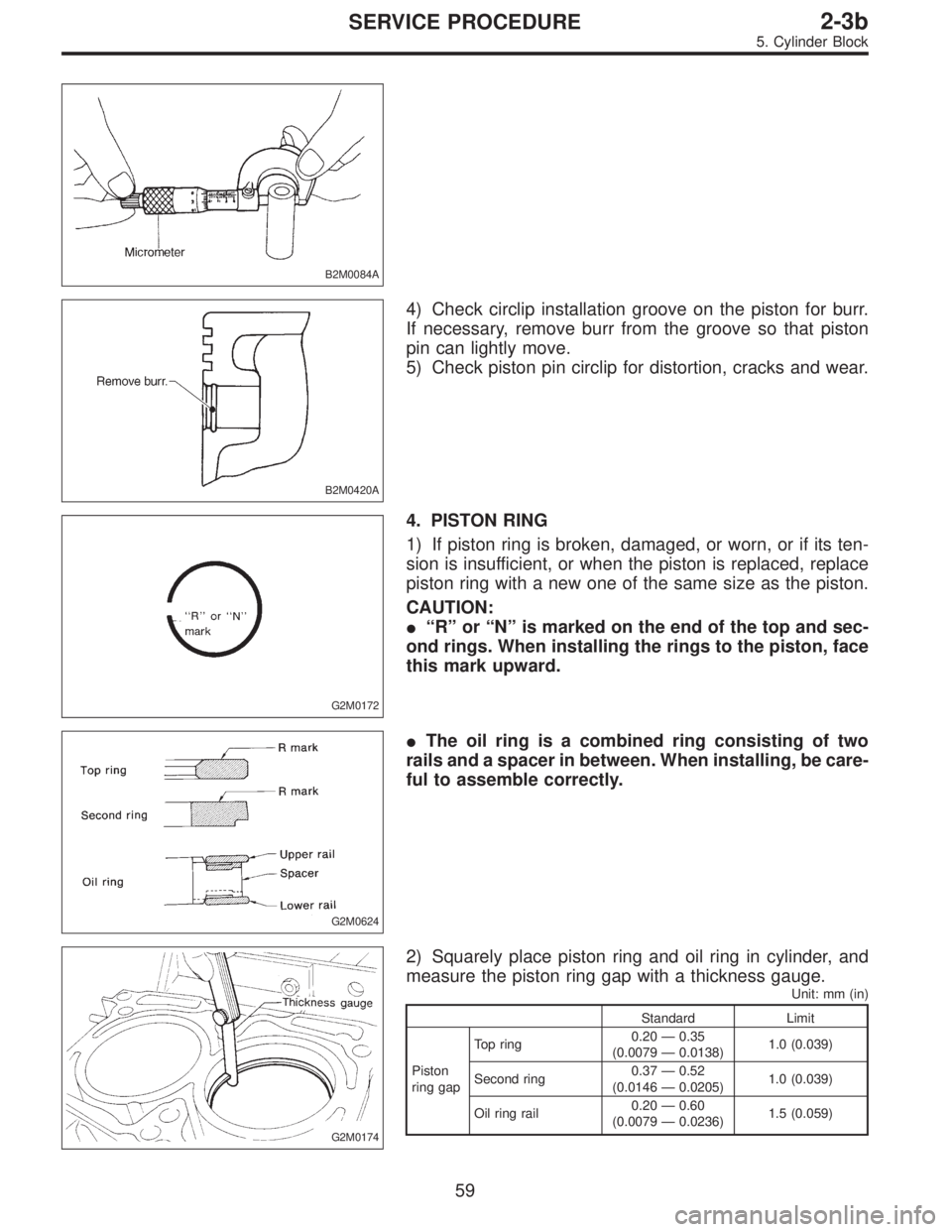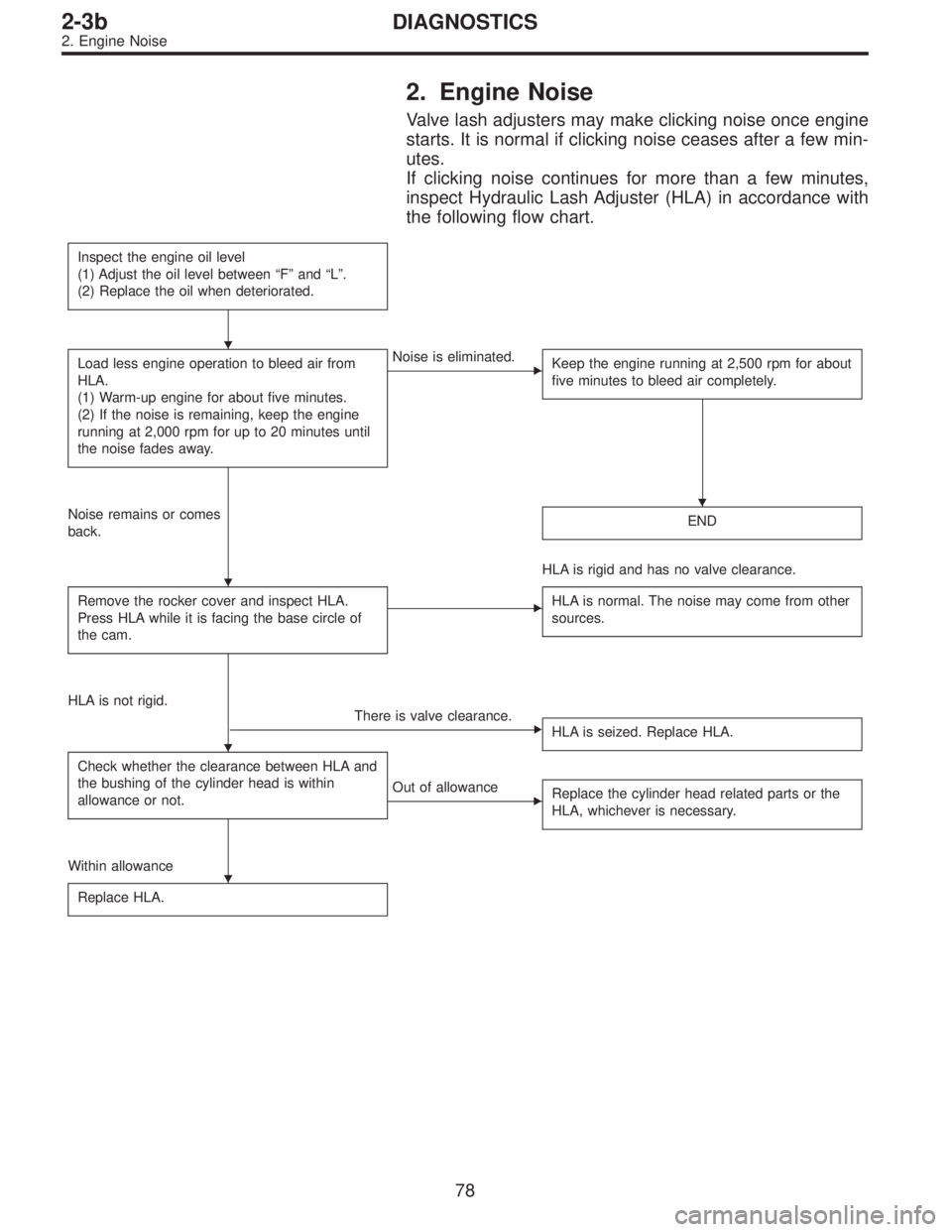Page 427 of 2890

G2M0762
2) If the clearance between valve guide and stem exceeds
the specification, replace guide as follows:
(1) Place cylinder head on ST1 with the combustion
chamber upward so that valve guides enter the holes
in ST1.
(2) Insert ST2 into valve guide and press it down to
remove valve guide.
ST1 498267600 CYLINDER HEAD TABLE
ST2 499767200 VALVE GUIDE REMOVER
G2M0763
(3) Turn cylinder head upside down and place ST as
shown in the figure.
ST 498267700 VALVE GUIDE ADJUSTER
G2M0764
(4) Before installing new valve guide, make sure that
neither scratches nor damages exist on the inside sur-
face of the valve guide holes in cylinder head.
(5) Put new valve guide, coated with sufficient oil, in
cylinder, and insert ST1 into valve guide. Press in until
the valve guide upper end is flush with the upper sur-
face of ST2.
ST1 499767200 VALVE GUIDE REMOVER
ST2 498267700 VALVE GUIDE ADJUSTER
(6) Check the valve guide protrusion.
Valve guide protrusion: L
12.0—12.4 mm (0.472—0.488 in)
(7) Ream the inside of valve guide with ST. Gently
rotate the reamer clockwise while pressing it lightly into
valve guide, and return it also rotating clockwise. After
reaming, clean valve guide to remove chips.
ST 499767400 VALVE GUIDE REAMER
CAUTION:
�Apply engine oil to the reamer when reaming.
�If the inner surface of the valve guide is torn, the
edge of the reamer should be slightly ground with an
oil stone.
�If the inner surface of the valve guide becomes lus-
trous and the reamer does not chips, use a new reamer
or remedy the reamer.
(8) Recheck the contact condition between valve and
valve seat after replacing valve guide.
39
2-3bSERVICE PROCEDURE
4. Cylinder Head
Page 428 of 2890

G2M0153
4. INTAKE AND EXHAUST VALVE
1) Inspect the flange and stem of valve, and replace if
damaged, worn, or deformed, or if“H”is less than the
specified limit.
H:
Intake
Standard
1.2 mm (0.047 in)
Limit
0.8 mm (0.031 in)
Exhaust
Standard
1.5 mm (0.059 in)
Limit
0.8 mm (0.031 in)
Valve overall length:
Intake 93.3 mm (3.673 in)
Exhaust 93.6 mm (3.685 in)
2) Put a small amount of grinding compound on the seat
surface and lap the valve and seat surface. Install a new
intake valve oil seal after lapping.
G2M0154
5. VALVE SPRINGS
1) Check valve springs for damage, free length, and ten-
sion. Replace valve spring if it is not to the specifications
presented below.
2) To measure the squareness of the valve spring, stand
the spring on a surface plate and measure its deflection at
the top using a try square.
Valve spring
Free length 39.8 mm (1.567 in)
Tension/spring height228.5—261.8 N
(23.3—26.7 kg, 51.4—58.9 lb)/31.0 mm
(1.220 in)
462.9—531.5 N
(47.2—54.2 kg, 104.1—119.5 lb)/23.2 mm
(0.913 in)
Squareness 2.5°, 1.7 mm (0.067 in)
40
2-3bSERVICE PROCEDURE
4. Cylinder Head
Page 429 of 2890

G2M0765
6. INTAKE AND EXHAUST VALVE OIL SEAL
Replace oil seal with new one, if lip is damaged or spring
out of place, or when the surfaces of intake valve and valve
seat are reconditioned or intake valve guide is replaced.
1) Place cylinder head on ST1.
2) Press in oil seal to the specified dimension indicated in
the figure by using ST2.
ST1 498267600 CYLINDER HEAD TABLE
ST2 498857100 VALVE OIL SEAL GUIDE
CAUTION:
�Apply engine oil to oil seal before force-fitting.
�Differentiate between intake valve oil seal and
exhaust valve oil seal by noting their difference in
color.
Color of rubber part:
Intake [Black]
Exhaust [Brown]
Color of spring part:
Intake [Black]
Exhaust [Black]
G2M0766
7. VALVE LASH ADJUSTER
1) Check valve lash adjuster visually.
2) Measure outer diameter of valve lash adjuster.
Outer diameter:
29.959—29.975 mm (1.1795—1.1801 in)
G2M0767
3) Measure inner diameter of bush on cylinder head.
Inner diameter:
29.994—30.016 mm (1.1809—1.1817 in)
CAUTION:
If difference between outer diameter of valve lash
adjuster and inner diameter of bush is over the limit,
replace cylinder head.
Standard:
0.019—0.057 mm (0.0007—0.0022 in)
Limit:
0.100 mm (0.0039 in)
41
2-3bSERVICE PROCEDURE
4. Cylinder Head
Page 444 of 2890
C: INSPECTION
1. CYLINDER BLOCK
1) Check for cracks and damage visually. Especially,
inspect important parts by means of red lead check.
2) Check the oil passages for clogging.
3) Inspect crankcase surface that mates with cylinder
head for warping by using a straight edge, and correct by
grinding if necessary.
Warping limit:
0.05 mm (0.0020 in)
Grinding limit:
0.1 mm (0.004 in)
Standard height of cylinder block:
201.0 mm (7.91 in)
B2M0082A
2. CYLINDER AND PISTON
1) The cylinder bore size is stamped on the cylinder
block’s front upper surface.
NOTE:
Standard sized pistons are classified into two grades,“A”
and“B”. These grades should be used as a guide line in
selecting a standard piston.
Standard diameter:
A: 99.505—99.515 mm (3.9175—3.9179 in)
B: 99.495—99.505 mm (3.9171—3.9175 in)
56
2-3bSERVICE PROCEDURE
5. Cylinder Block
Page 447 of 2890

B2M0084A
B2M0420A
4) Check circlip installation groove on the piston for burr.
If necessary, remove burr from the groove so that piston
pin can lightly move.
5) Check piston pin circlip for distortion, cracks and wear.
G2M0172
4. PISTON RING
1) If piston ring is broken, damaged, or worn, or if its ten-
sion is insufficient, or when the piston is replaced, replace
piston ring with a new one of the same size as the piston.
CAUTION:
�“R”or“N”is marked on the end of the top and sec-
ond rings. When installing the rings to the piston, face
this mark upward.
G2M0624
�The oil ring is a combined ring consisting of two
rails and a spacer in between. When installing, be care-
ful to assemble correctly.
G2M0174
2) Squarely place piston ring and oil ring in cylinder, and
measure the piston ring gap with a thickness gauge.
Unit: mm (in)
Standard Limit
Piston
ring gapTop ring0.20—0.35
(0.0079—0.0138)1.0 (0.039)
Second ring0.37—0.52
(0.0146—0.0205)1.0 (0.039)
Oil ring rail0.20—0.60
(0.0079—0.0236)1.5 (0.059)
59
2-3bSERVICE PROCEDURE
5. Cylinder Block
Page 450 of 2890
B2M0085
6) Inspect bushing at connecting rod small end, and
replace if worn or damaged. Also measure the piston pin
clearance at the connecting rod small end.
Clearance between piston pin and bushing:
Standard
0—0.022 mm (0—0.0009 in)
Limit
0.030 mm (0.0012 in)
B2M0084A
G2M0177
7) Replacement procedure is as follows.
(1) Remove bushing from connecting rod with ST and
press.
(2) Press bushing with ST after applying oil on the
periphery of bushing.
ST 499037100 CONNECTING ROD BUSHING
REMOVER AND INSTALLER
(3) Make two 3 mm (0.12 in) holes in bushing. Ream
the inside of bushing.
(4) After completion of reaming, clean bushing to
remove chips.
6. CRANKSHAFT AND CRANKSHAFT BEARING
1) Clean crankshaft completely and check for cracks by
means of red lead check etc., and replace if defective.
62
2-3bSERVICE PROCEDURE
5. Cylinder Block
Page 453 of 2890
D: ASSEMBLY
1. CRANKSHAFT AND PISTON
B2M0127A
Tightening torque: N⋅m (kg-m, ft-lb)
T: 44±2 (4.5±0.2, 32.5±1.4)
1) Install connecting rod bearings on connecting rods and
connecting rod caps.
CAUTION:
Apply oil to the surfaces of the connecting rod bear-
ings.
2) Install connecting rod on crankshaft.
CAUTION:
Position each connecting rod with the side marked
facing forward.
3) Install connecting rod cap with connecting rod nut.
Ensure the arrow on connecting rod cap faces the front
during installation.
CAUTION:
�Each connecting rod has its own mating cap. Make
sure that they are assembled correctly by checking
their matching number.
�When tightening the connecting rod nuts, apply oil
on the threads.
65
2-3bSERVICE PROCEDURE
5. Cylinder Block
Page 466 of 2890

2. Engine Noise
Valve lash adjusters may make clicking noise once engine
starts. It is normal if clicking noise ceases after a few min-
utes.
If clicking noise continues for more than a few minutes,
inspect Hydraulic Lash Adjuster (HLA) in accordance with
the following flow chart.
Inspect the engine oil level
(1) Adjust the oil level between“F”and“L”.
(2) Replace the oil when deteriorated.
Load less engine operation to bleed air from
HLA.
(1) Warm-up engine for about five minutes.
(2) If the noise is remaining, keep the engine
running at 2,000 rpm for up to 20 minutes until
the noise fades away.�Noise is eliminated.
Keep the engine running at 2,500 rpm for about
five minutes to bleed air completely.
Noise remains or comes
back.END
HLA is rigid and has no valve clearance.
Remove the rocker cover and inspect HLA.
Press HLA while it is facing the base circle of
the cam.
�HLA is normal. The noise may come from other
sources.
HLA is not rigid.
There is valve clearance.
Check whether the clearance between HLA and
the bushing of the cylinder head is within
allowance or not.
HLA is seized. Replace HLA.
�Out of allowance
Replace the cylinder head related parts or the
HLA, whichever is necessary.
Within allowance
Replace HLA.
�
�
�
�
�
�
78
2-3bDIAGNOSTICS
2. Engine Noise